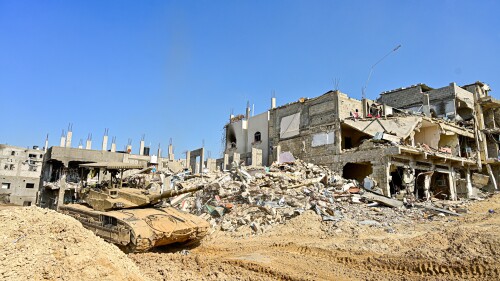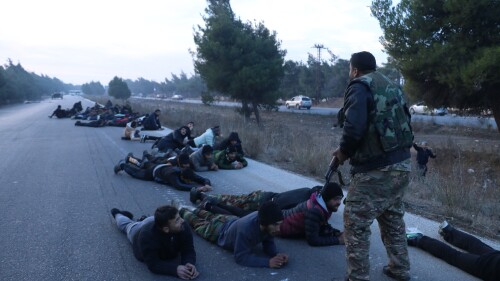Originally published under the headline “The logic behind Iranian moves in the Middle East.”
The effort by the US and its allies to contain and ultimately roll back the gains made by Iran in the region over the last half decade is currently taking shape, and is set to form the central strategic process in the Middle East in the period now opening up.
New sanctions on the export of Iranian oil are due to be implemented from November 4. Israel’s campaign against Iranian entrenchment in Syria is the most important current file on the table of the defense establishment.
The US appears set now to maintain its assets and its allies in Syria as part of the emergent strategy to counter Iran. In Iraq, the contest between Iran-associated forces and those associated with the US is the core dynamic in the country, with the independent power on the ground of the Iran-associated Shia militias the central factor. In Yemen, the battle of attrition between the Iran-supported Ansar Allah (Houthis) and the Saudi and UAE-led coalition is continuing, with limited but significant gains by the latter.
Iran’s response is also becoming clear. At the present time, Tehran’s ballistic missile capabilities appear to be the preferred instrument for Tehran to express its defiance.
Notably, for the moment at least, Iran appears to be erring on the side of caution in its choice of targets. This phase is unlikely to last, however, assuming the US is serious in its intentions.
|
|
In the early hours of Monday, October 1, the Fars News Agency, associated with the Islamic Revolutionary Guard Corps, reported that the IRGC had fired a number of Zulfiqar and Qiyam ballistic missiles at targets east of the Euphrates River in Syria. The strike came in response to an attack on an IRGC parade in Iran’s Arab-majority Khuzestan province on September 22. According to Fars, the missiles fired were decorated with slogans including “Death to America,” “Death to Israel,” and “Death to Al Saud.”
It is noteworthy, however, that the missiles were not directed at any of the aforementioned enemies of the Islamic Republic of Iran. Rather, the IRGC targeted the Hajin pocket, a small enclave east of the Euphrates still held by Islamic State. This was in response to a claim of responsibility by ISIS for the September 22 attack. (A somewhat more credible claim was made by the Ahwaziya, or Ahvaz national resistance, an Arab separatist group in Khuzestan.) Iranian Supreme National Security Council Secretary Ali Shamkhani later tried to frame the attack as a response to American threats, because of the close proximity of the US-backed Syrian Democratic Forces to the area targeted.
| |
Similarly, on September 8, the IRGC fired seven Fateh-110 short-range missiles at a base maintained by the PDKI (Democratic Party of Iranian Kurdistan) in the city of Koya in eastern Iraq. The PDKI is engaged in an insurgency against the IRGC and the Iranian regime, centered on the Kurdistan Province of western Iran. Eleven people were killed in the attack. In both these cases, Tehran chose to make its demonstrations of strength against the very weakest of the forces opposed to it (in the case of Islamic State, a force indeed mainly engaged against the enemies of Iran). Shamkhani’s bluster after the fact tends to draw attention to this, rather than detract from it.
By contrast, when Iran wishes to act against or threaten the interests of any of the powerful states whose names were written on the missiles fired at ISIS in Hajin, it takes care to do so in ways that avoid attribution. Thus, the Lebanese Hezbollah organization, in military terms a direct tributary of the IRGC, is the force entrusted with the missile array facing Israel.
When ballistic missiles are fired at Riyadh from Yemen, the act is claimed by the Houthis, and the missiles are identified as “Burkan 1" and “Burkan 2" missiles, developed in Yemen. These missiles are considered by the US State Department and senior US officers to be Iranian in origin, possibly the Qiam 1 or Shihab 2 system with minor modifications. Certainly, the Houthis, a lightly armed north Yemeni tribal militia, did not acquire the knowledge required to operate ballistic missiles locally. There is evidence to suggest that Lebanese Hezbollah operatives are engaged by Iran in Yemen to carry out these launches.
In Iraq, according to a Reuters report in August, the IRGC has begun to transfer ballistic missiles to its militia proxies in that country, presumably with the intention of using these against Israeli or US personnel.
So Iran acts through deniable proxies in its wars against powerful states, but acts directly only against small and marginal non-state paramilitary groups. The purpose, of course, is to enable the Iranian state to avoid retribution, while gaining benefit from the acts of the militias.
This practice has proven effective in recent years, though it projects weakness as much as strength. It is of use only for as long as Iran’s enemies are willing to participate in the fiction of separation between the IRGC and its client militias.
At a certain point, if the US and its allies are serious about rolling back Iran from its regional gains, the question will arise as to whether success in this endeavor can coexist with the tacit agreement to maintain this fiction. In Israel’s case, the decision to cease adherence to this convention was taken earlier this year, when Israeli aircraft began openly targeting Iranian facilities in Syria.
For the US, such a decision is likely to emerge, if it emerges, as a result of the dynamics set in motion by the decision to challenge Iran’s advances.
At the moment, what is taking place is something of a “phony war": missile strikes against peripheral targets, grandiose threats from the IRGC leadership, supplying of militias with this or that weapon system.
If Tehran begins to feel that its interests are truly threatened, however, this period is likely to come to an end. When it does so, Tehran is likely to seek to hit at the US at its most vulnerable points – the US forces and official facilities in Iraq and Syria. Such actions will almost certainly be taken not by the IRGC itself, but, rather, by this or that proxy set of initials. It may come through the use of missiles, or by a variety of other means.
At that point, the US will need to decide whether retribution will be inflicted only on the proxies, or on those sending them. The pattern of Iran’s behavior suggests a great sensitivity toward not including Iranian personnel within the sphere of conflict. This is a vulnerability that should be exploited. The success, or the frustration of the effort to turn back Iran’s advance across the region, may thus depend on the decision taken as and when Iran chooses to end the current “phony war.”
Jonathan Spyer is a Writing Fellow at the Middle East Forum, a research associate at the Jerusalem Center for Strategic Studies, and a columnist at the Jerusalem Post. He is the author of The Transforming Fire: The Rise of the Israel-Islamist Conflict.









